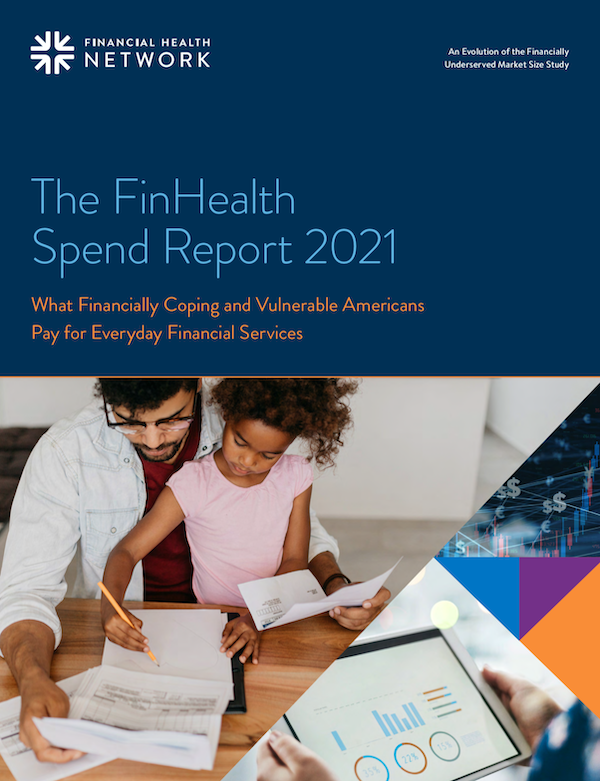FinHealth Spend Report uncovers market opportunities and need for innovation
In 2020, as Americans faced unprecedented unemployment, lockdowns, and health and financial uncertainty, many families restricted their spending.
Despite belt tightening on discretionary spending, households in the US continued to depend on the financial services they need to power their everyday lives. According to the newly released 2021 FinHealth Spend Report – developed in partnership by Financial Health Network with Prudential Financial – in 2020 Americans spent more than $300 billion in interest and fees across dozens of common financial services, including car loans, credit card balances, and account maintenance fees.
The bulk of that spending – $255 billion – came from families who were struggling financially. In fact, the report found that people who are struggling with their financial health, Black and Latinx households, and low- to moderate-income (LMI) households spent a greater share of their incomes on interest and fees for financial services than their counterparts.
The pandemic laid bare the deep economic and racial inequities of our system, with the brunt of the economic pain from the crisis laid on families that were already financially vulnerable. Through this report, we find that financial services were no exception.
Specifically, in 2020:
- LMI households spent on average 7% of their incomes on interest and fees for financial services, compared to 3% among high-income households.
- Black households spent 6%, and Latinx households 5%, of their incomes, versus only 3% for White households.
- Financially vulnerable households – those who struggle with nearly all aspects of their financial lives, according to the Financial Health Network’s FinHealth Score methodology – spend a whopping 13% of their annual incomes, compared to just 1% for those classified as financially healthy.
These population segments pay more for financial services across a wide range of products, perpetuating inequities in consumer financial health. For example, they more frequently turn to high-cost alternative financial services: according to our research, Black households are 3.8 times more likely to use payday loans than White households, while Latinx households are 3.1 times more likely. Most of these loans are not one-offs. The Center for Responsible Lending estimates that 91% of payday loans are made to repeat borrowers. Meanwhile, LMI respondents in our survey were seven times more likely to turn to pawn loans than higher-income households.
There are also steep penalties for balances that dip into the red. More than 40% of financially vulnerable families with checking accounts have overdrafted in the past year, reporting close to ten overdrafts on average. With an average overdraft charge of $35, this means families are paying hundreds of dollars a year.
Even when accessing more mainstream forms of credit, these households pay more. 57% percent of households classified as financially vulnerable (who are also more likely to have low incomes and be Black or Latinx) report poor or no credit scores, compared to 1% among the financially healthy. This can lead to rates as high as 20% for auto loans.
Our research revealed that families are spending billions annually on financial services that they rely on for their daily lives. However, spending tells only part of the story. Ultimately, we need to understand and evaluate financial services on the value they bring to a customer: do they help families better weather emergencies and take advantage of opportunities? How do they impact people’s financial health?
The Financial Health Network is building a movement of providers committed to financial health, and a growing number of financial service companies – ranging from incumbents to fintech start-ups – are adopting business practices that promote financial health.
A first step can be to measure the financial health of customers in order to more deeply understand their financial realities and needs. This can then provide an important springboard for designing supportive products in line with the Compass Principles, which outlines guidelines that support responsible expansion of access and increased prosperity. And we have laid out an actionable framework for companies to build a holistic strategy that leads to financial health impact for customers, employees, and communities.
Our network is diverse and growing, with members innovating with new products and services, evaluating their impact, and sharing their learnings.
The FinHealth Spend Report uncovers vast market opportunities – and need – for innovative providers willing to push for high-quality solutions committed to financial health. We hope our data spurs exploration and innovation in support of improved financial health for all.












































